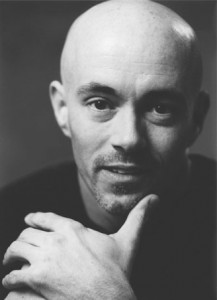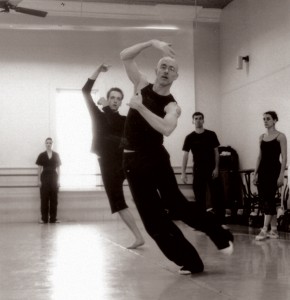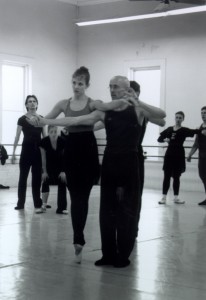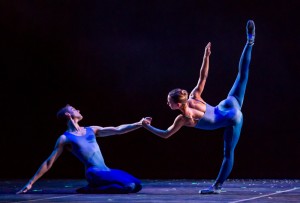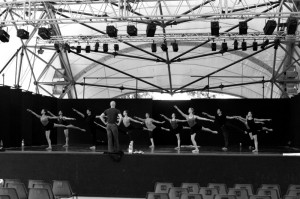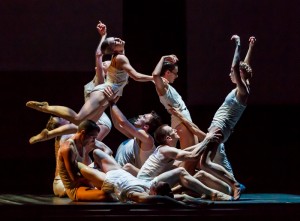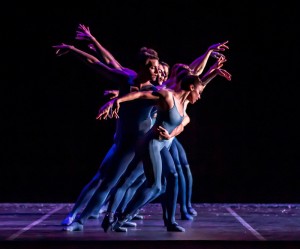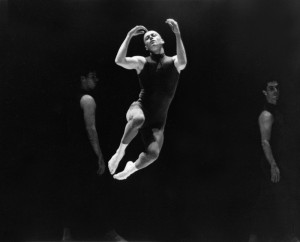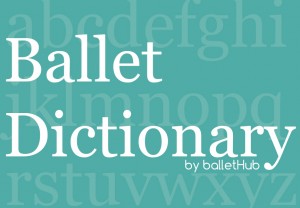BalletHub: Thanks for joining us today Stephen! To start off, how did you get started with ballet?
Stephen Mills: I was raised in a small town in Kentucky where exposure to art and performances were confined to school activities. Because I was interested in music, my mother found a woman to teach me piano. Music became something at which I excelled. In high school I was in the drama club and was able to attend college on a theater scholarship.
As part of my theater requirements I experienced a ballet class for the first time at eighteen years of age. It was the most physically engaged and excited I had ever been and began to study full time. During that period I had my first live dance experience watching the Cincinnati Ballet perform Swan Lake Act II and Concerto Barocco. It was then that I decided I had to have a career in dance.
By age eighteen many dancers are beginning to look for jobs, while you were just starting your training, but that obviously didn’t stop you. How intense did your dance training schedule become? Was the demanding physicality of dancing natural for you?
I was blessed with a body that was flexible, a quick mind, and a determination to dance. I simply didn’t know what I didn’t know; meaning I didn’t realize how impossible the task at hand was. So, I jumped in and found every class I could take. Though my desire was to dance in a classical company, it was unclear whether my late start would make eliminate that goal. I studied ballet, modern in all its forms, jazz, tap and even African dance at The Ailey School. At the time I was really just exploring something with which I was deeply infatuated. Ultimately, I danced with The Harkness Ballet and The American Dance Machine in New York. Each company’s mission was distinctly different but allowed me to dance in work that was extremely diverse. Later I danced in a company where I was able to work with Ohad Naharin, Katherine Posin and Mark Dendy. So, I would say my “mutt” status concerning training paid off well.
People who aspire to be artists of any type have to pay attention to all things happening around them.
You’ve created over 40 works for several companies in the United States and abroad, obviously you have a passion for it. What first interested you in becoming a choreographer?
When I was young I attended the College-Conservatory of Music at the University of Cincinnati in the music program. I studied piano and composition and was always interested in the way things were organized. When I was about twelve I was fixated on composing marches, much to my mother’s frustration.
So, as a dancer within a dance I always found myself wondering about the construction of the piece; why the choreographer made particular choices and the myriad choices that could have been made. Watching a dance from the inside, if you’re a curious person, is always interesting. As a result I found myself thinking about choreography from the beginning.
I am very much an introvert and the performative aspect of dance was never very interesting to me. Making dances has always been a way to participate in the form without being physically onstage.
What was your first commissioned work?
The first work I made for a professional company was Ballet Austin. The directors at the time, knowing I had an interest, asked me to make something small for a summer time park performance. I used music from Philip Glass‘ film score Powaqqatsi and enjoyed every minute of the process. From there I was invited to make more work for the company and began to develop a freelance career.
The first company outside Ballet Austin to commission work was The Dayton Ballet. Since that time I have worked with American Ballet Theater Studio Company, The Hong Kong Ballet, Atlanta Ballet, Pittsburgh Ballet Theater, Colorado Ballet and many others.
What advice would you give to our readers who are aspiring choreographers?
People who aspire to be artists of any type have to pay attention to all things happening around them. If someone isn’t curious about life, relationships or construction attempting to make art, write stories or choreographing dances isn’t for them. Experiment and play in the studio – look at art – listen to and study all forms of music and its structure. It’s important not to exclude experiences which might inform your dance making. Choreography is much more than steps.
Then, if one is curious and has a need to make dances they should make dances; learn by doing. There isn’t an academy for dance makers. I began making dances on friends during time off. Dancers are generous with their time and always eager to participate in making something new. Additionally there may be a school looking for a choreographer to make work for their young dancers. No opportunity is too small or insignificant to learn something. Early on in my career I choreographed student dances, musicals and even fashion shows. These are low stress, no risk opportunities to make dances and learn.
An aspiring choreographer should look at as much dance, in all it iterations, as is possible. Don’t be judgmental about what is and isn’t dance. YouTube is an amazing tool to explore multiple genres of dance when costs prevent travel. But for a choreographer, viewing a live performance is better than watching online. Dance is communicative and is better received in person. Being in the theater or performance space allows you to see not only how you react as a viewer but how an audience responds. Unfortunately, most audience members watch dance passively. A choreographer watching another artist’s work has to sit forward and think about why a piece is successful or not. After making a dance enjoy the satisfaction of having made it and feel good about it…then, tear it apart because learning is in the questioning.
Art has always been a reflection of the time and culture in which it is made. I don’t think there is a right or wrong direction; it can’t be controlled anyway.
That is great advice! You mention curiosity a few times. How much of a role do you think that plays in choreographing?
Whether a choreographer is making a narrative work or not the dance is, from my perspective, always a theatrical experience. No matter the venue or context, an audience will question the dancer’s relationships to each other. Whether the choreographer intends it or not an audience will look for metaphor and meaning. So it’s best for the choreographer to think about it. For me in my practice dance is about life and the many ways in which we relate, think and feel. If an artist, or any person for that matter, isn’t curious about these things it makes for a very narrow perspective in life.
Creativity cannot happen without curiosity. When making a work the process has to start with as many ideas as possible and then edit to the one that is most essential. If one isn’t curious how are ideas generated?
If you could use one word to describe your choreography as a whole, what would it be?
Musical. While music isn’t necessary to make a good dance, and I haven’t always used music for pieces, my musical training is ingrained in my dance making process. I am very much aware of musical forms and structure and cannot help working with them when making a dance.
In 2000, you became the Artistic Director of Ballet Austin. How were you first presented with this opportunity and how was the transition from dancing and choreographing full-time?
In 1998 the board of directors of Ballet Austin decided to change artistic leadership of the organization. At the time I was acting as rehearsal director for the company and was invited to lead the dancers while an international search was held. At the end of the search I became the successful candidate and the leadership of the organization was offered to me.
There is really no preparatory course for becoming an artistic director and it is a very challenging job. An artistic director has to be motivational, communicative and visionary. He or she also must be strategic and financially responsible. When I was a dancer I honestly thought that the Board decided how much to spend on a season and divided that cost amongst their members. I didn’t understand the role of development within the organization. It is impossible to understand the myriad responsibilities, from marketing and development, that is within the portfolio of the artistic director.
As well, dancing and choreographing does not prepare one to serve in a leadership role. When dancing or making work the focus has to be on yourself because the art resides within the artists. But when leading a team the focus has to be on the team members as individuals. That shift can be challenging. Balancing the needs of the artistic team with the needs of the entire organization can be difficult. While the entire reason for an artistic organization to exist is the art, the entire organization’s financial security requires thoughtful and reasoned choices. When I became artistic director someone asked what I would do now that I could do anything. Now I just laugh at that idea.
Out of the gate as the new Artistic Director, Ballet Austin performed a world-premiere of your Hamlet and continues to perform many of your own works both classical and contemporary. How are you able to balance both being a director and actively choreographing every season?
Hamlet was an important work because it immediately defined the new identity of our company. Since its creation in 2000 it has been performed more often that any other work I’ve made besides The Nutcracker. The dance is in the repertoires of five different companies and will be reprised by The Atlanta Ballet in the spring.
I believe people connect to dance because of the body and its unique ability to communicate that which is human.
I have made a lot of work for our company, mainly because I’m a choreographer who wants to work, but also because it defines our company as being different from others. My goal for Ballet Austin is that it have an identity apart from others. That’s an easier task when an organization is led by a working choreographer. I am able to be in the studio because I’ve made that a priority and have assembled a team around me to make it possible.
Obviously there are times when I am not required in the studio. Our biennial choreographic prize New American Talent/Dance is one such time where visiting artists are here making new work and are assisted by our Associate Director and Rehearsal Director. Periods such as this allow me time to focus on brainstorming for new work, writing, or working on freelance jobs.
You’ve created a critically acclaimed and awe-inspiring work, Light / The Holocaust & Humanity Project, which abstractly tells the story of a real Holocaust survivor. What gave you the idea and how was it that you prepared to create it?
After the events of 9-11 I began to wonder how I might have a richer community conversation within my practice as a dance maker. As Americans, I think we were all grieving and trying to make sense of the horror of the attack and what it meant to be that vulnerable. As an artist, I was looking for a way to communicate my own feelings about it as we were facing the unnecessary catastrophe of a war.
During this process I was introduced to a Holocaust survivor named Naomi Warren. It was suggested to me that her story might be interesting as a narrative to help me in my quest. Naomi had survived three concentration and death camps: Auschwitz/Birkenau, Ravensbrook and Bergen-Belsen. During this time Naomi lost many members of her family including her mother who was separated and killed upon arrival at Auschwitz. Throughout her testimony, even through the most graphic details, Naomi was brave, honest and spared nothing. Naomi believes that it is everyone’s responsibility to use whatever platform they possess to speak out when confronted with acts of bigotry and hate. She suggested that as an artist with access it was my duty to act.
I began to envision this work as a social justice piece that could use the lessons of the Holocaust to teach about present day issues of genocide and human rights. Sometimes art and metaphor can teach a lesson more potently than words. Dance has a special way of getting to the point very quickly.
That is quite an incredible story. You mention that “dance has a special way of getting to the point very quickly.” How do you feel dance compares to other artistic mediums in expressing ideas or emotions?
People have very different ways of relating to art. Some people love music because they may have a heightened aural sense. Some love visual art because they relate to the architecture of a painting, sculpture or installation. I believe people connect to dance because of the body and its unique ability to communicate that which is human. Stravinsky used to say that music could communicate nothing. Perhaps Balanchine felt that as well. I also believe this to be true. It’s not the piece that is communicating ideas or emotions but the viewer who is receiving the work and making meaning from it.
I think we can all agree that body language can sometimes speak louder than words. There is a physical communication we all understand when we see someone who is excited, sad or in love. No words are necessary. When one reads a photograph it is easy to create a story based upon facial expressions and the physical gesture.
I’m not sure one artistic medium is more communicative than another. Some forms resonate more deeply with some more than others.
For our work to survive it’s crucial to draw lines of relevance from the art into the community. I think Light does that.
Light received so much acclaim and attention that you were approached to have a documentary made to cover the details from inception to performance. How were you first approached about making the documentary?
PBS created an hour long documentary about Light/The Holocaust & Humanity Project in 2012. Our local station KLRU was a major collaborator in our Project. The film titled Producing Light intertwines Naomi’s story with mine and illuminates the ways in which art can convene a community wide conversation.
Art can’t change the world, only people can do that. But art can cause conversation. Art can teach important lessons. The film maker Karen Berstein, who has produced work for American Masters on PBS, followed the company and me around for about five weeks. And I truly believe she was able to produce a film which encapsulates what the project is about: artists, activists and city leaders coming together to engage in a dialogue about meaningful change in a community.
We’re very proud of the piece and it was recently awarded an Emmy Award. Additionally, I was invited to create a podcast for the United States Holocaust Memorial Museum in Washington, DC. Their series Voices on Anti-Semetism has included individuals such as Dr. Elie Wiesel and former Secretary of State Madeleine Albright among many others. Light will now always be part of the USHMM archive. It’s an unbelievable honor.
Ballet Austin, as well as other companies, has performed Light numerous times and now will perform it on a tour to Israel this September. Do you have any expectations on how the audiences will receive the performances?
As Americans we have a cinematic view of life. The narrative is often of a tragedy averted at the last minute by a hero. While the history of The Holocaust includes many survivors and countless acts of heroism, millions of people were murdered or died of illness or starvation. And even though the story of a survivor includes hope, resilience, luck and gratitude for surviving it equally includes unimaginable loss, disillusionment and pain. They carry with them images that cannot be erased.
When the performances of Light/The Holocaust & Humanity Project have taken place in the myriad American cities it has visited the majority of the audiences have included both Jews and non-Jews and a handful of survivors or their children. In Israel the audience will include majority survivors, their children and grandchildren. The Israeli perspective will definitely be different as their relationship to the history is different.
The company will perform in the Western Galilee area at the Acco Festival. We will then perform twice in Tel Aviv at the Suzanne Dellal Center which is the home of Batsheva Dance Company. And the venue for our performance in Jerusalem will be The Gerard Behar Theater. The Gerard Behar Theater is special as it is the site where the Adolph Eichmann trials took place. This is significant because Eichmann was the first Nazi war criminal held to account in Israel for the atrocities committed during the Shoah. It is a hallowed site for Israelis and it is an awe inspiring opportunity for us to perform this dance in this space; especially realizing there will perhaps be people in our audience who attended the original trials almost fifty years ago.
An aspiring choreographer should look at as much dance, in all its iterations, as is possible.
Would you agree if someone said “The landscape of ballet is constantly evolving.” Do you think it’s headed in the right direction?
Ballet is evolving as is everything. Evolve or Die. Art has always been a reflection of the time and culture in which it is made. I don’t think there is a right or wrong direction; it can’t be controlled anyway. There are very interesting hybrids happening right now. I wonder what Anna Pavlova, the most famous Dying Swan would think of hip-hop dancer L’il Buck’s rendition of her dance? The ways in which art and technology are colliding is exciting. Conversely, I’m not sure I’d want to see Swan Lake performed by technicians from the nineteenth century. Nothing stays the same; training has changed, bodies have changed, audiences connection to the art form has changed.
What are your interests outside of your busy career in dance?
Visual art is something I am very interested in. My partner and I collect and enjoy going to art fairs and exhibitions. This past summer we went to the Venice Biennale in Italy. It’s an incredible gathering of contemporary art in an ancient city so the contrasts are very shocking.
We also enjoy traveling to dance festivals in Lyon and Montpellier, France as well as Impulztanz in Vienna. Our interests seem to revolve around culture.
Where do you see yourself in 10 years?
I don’t think anyone knows where they’ll be or what they’ll do in ten years. The beautiful thing about life is not knowing. One opportunity leads to the next and hopefully I’m smart enough to take advantage of the opportunities I’m given and do something special. Personally, my work in social justice through Light/The Holocaust & Humanity Project has been extremely important to me.
The collaborations within communities where it’s been staged has been among the most consequential of my career. I hope to be able to extend the effects of that work because I think it’s valuable. For our work to survive it’s crucial to draw lines of relevance from the art into the community. I think Light does that.
Do you have any advice for young boys interested in starting dance?
Boys have to be extremely motivated to dance in order to be successful. Unfortunately, boys are still stigmatized and bullied for wanting to dance. But the advice I would give a boy is the same as I would give to anyone whether they dance or not.
1. Remain a student. 2. Be curious. 3. No one is perfect nor ever completely formed so keep striving to be better. 4. Be patient with yourself and others. 5. Tolerance.
Thank you so much for sharing some of your story with us today. We wish you continued success in your ongoing career as a director and choreographer!
You’re welcome and good luck!

